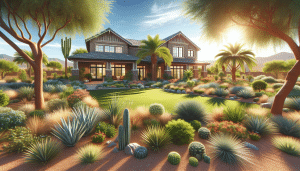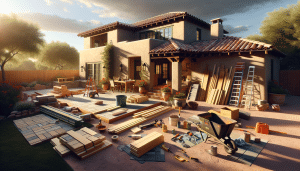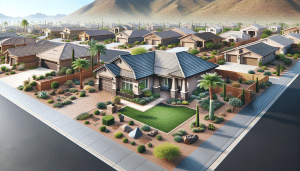You’ve got that itch, don’t you? You look out the back window at your Queen Creek home and see potential. Or maybe you just see a bunch of weeds and that dusty, rock-hard dirt we all know too well. Either way, the idea of transforming your backyard into a personal oasis is stuck in your head. It’s exciting, honestly. There is something deeply satisfying about getting your hands dirty and building something beautiful from scratch. But let’s be real for a second—it can also be a little terrifying.
Starting a DIY backyard design project isn’t just about buying a few plants and tossing down some gravel. It’s about creating a space where you actually want to spend time. You know, a spot for the grill, maybe a fire pit for those cool desert nights, or a play area for the kids.
Before you run out to the hardware store and load up the truck, take a breath. We need to talk about what goes into a design that actually works in our climate. Because here in Arizona, the sun doesn’t mess around, and neither should your plan.
Contents
The “Back of the Napkin” Phase
Most great projects don’t start on a computer; they start on a scrap of paper. Or a napkin. Seriously, grab whatever you have and sketch it out. You don’t need to be an artist. You just need to understand your space.
Start by looking at what you already have. Where does the sun hit hardest in the afternoon? Where are the shadows? In Queen Creek, shade is currency. If you design a beautiful seating area right where the sun blazes at 4:00 PM in July, you’re never going to use it. It’ll just be a hot slab of pavers frying your furniture.
Think about “zoning” your yard. It sounds fancy, but it just means grouping things together. Keep the cooking area near the kitchen door so you aren’t carrying steaks across the entire yard. Put the noisy stuff, like the pool pump or the AC unit, away from where you want to relax. It’s logic, mostly.
Understanding the Arizona Ground (The Hard Truth)
Here is the thing nobody tells you on those TV renovation shows: digging in Arizona is a workout. If you have ever tried to put a shovel into the ground here, you know what I’m talking about. We are dealing with caliche—that layer of cemented calcium carbonate that feels more like concrete than dirt.
Why does this matter for design? Because it changes what you can plant and how you drain water. If you dig a hole for a tree into heavy clay or caliche and fill it with water, it acts like a bathtub. The water sits there, the roots rot, and your expensive new tree dies. It’s heartbreaking, and it happens all the time.
When you are planning your landscape layout, you have to think about drainage. We might not get rain often, but when the monsoons hit, they hit hard. You need to ensure the ground slopes away from your foundation. This is called grading. If you ignore this step, you could end up with a flooded patio or, worse, water damage to your home. So, plan for where the water goes before you plant a single flower.
Hardscaping: The Bones of the Backyard
Let’s talk about the permanent stuff. In the industry, we call this hardscaping. This includes your pavers, concrete, retaining walls, and fire pits. This is the skeleton of your yard. The plants are just the clothes.
Choosing materials is tricky. You might love the look of dark slate, but have you ever stepped on a dark rock in the middle of an Arizona summer? It’ll melt your flip-flops. Lighter colors, like travertine or light concrete pavers, reflect the heat and stay cooler. It’s a small detail that makes a massive difference in comfort.
Also, don’t underestimate the labor here. Laying pavers looks easy on YouTube. “Just put down some sand and tap it in!” right? Well, not exactly. You need a compacted base layer of aggregate, then bedding sand, then the pavers, then joint sand. If you skip the base, your patio will look like a roller coaster within a year as the ground settles. It’s physically demanding work, but if you get the base right, the rest is manageable.
Softscaping: Choosing Plants that Won’t Quit
Now for the fun part—the greenery. Or, since we are in the desert, the “green-ish and brown-ish”ery. Just kidding. You can actually have a lush, colorful yard in Queen Creek if you pick the right stuff. This is where xeriscaping comes in.
Xeriscaping isn’t just cactus and rocks. It’s about choosing plants that are adapted to our climate so you aren’t dumping thousands of gallons of water on them just to keep them on life support. Native plants are your best friends here. They handle the heat, they handle the cold snaps, and they generally leave you alone.
Consider these winners for your DIY list:
- Texas Sage: Tough as nails and blooms with purple flowers when the humidity rises.
- Lantana: Adds a pop of color (yellow, orange, purple) and loves the sun.
- Agave: sculptural and dramatic. Just watch out for the tips!
- Mesquite or Palo Verde trees: They provide that filtered shade we need without blocking the breeze.
A quick tip on planting: Don’t plant for the size the plant is now. Plant for the size it will be in five years. That cute little one-gallon bush might grow to be six feet wide. If you plant it right next to your walkway, you’ll be hacking it back every weekend. Give them room to breathe.
The Lifeline: Irrigation and Lighting
You can’t skip this. You just can’t. Unless you want to stand outside with a hose for an hour every day (and who has time for that?), you need an automated drip irrigation system. In the desert, water is life. A drip system delivers water right to the roots where it’s needed, minimizing evaporation.
Installing irrigation is a puzzle. You have to figure out the pressure, the zones, and the timing. You don’t want your cactus on the same watering schedule as your citrus tree. One will rot, and the other will dry out. It’s a balancing act.
And then there is lighting. Have you ever been to a backyard party where the only light was a blinding floodlight from the back door? It kills the mood, doesn’t it? Low-voltage landscape lighting changes everything. A few well-placed path lights or uplights on a tree can make your yard look like a resort. Plus, it’s safer for walking around at night.
| System Type | Best For | DIY Difficulty |
|---|---|---|
| Drip Lines | Shrubs, Trees, Cacti | Moderate |
| Sprinklers | Grass Turf | High |
| Low-Voltage LEDs | Pathways, Trees | Easy to Moderate |
Budgeting and Reality Checks
Let’s talk numbers for a second. DIY is usually cheaper, but not always. By the time you rent the bobcat, buy the specialized tools you’ll use once, and pay for the mistakes (we all make them), the savings can shrink.
And then there is the “sweat equity.” Hauling three tons of gravel in a wheelbarrow when it’s 105 degrees out is… well, it’s an experience. It builds character, sure, but it also hurts your back. Be realistic about what you can handle. Maybe you do the planting and the low-voltage lighting yourself, but you hire someone for the heavy grading and the paver installation.
There is no shame in a hybrid approach. In fact, it’s usually the smartest way to go. You get the professional finish on the hard stuff, and the personal touch on the garden.
Making It All Flow
The best backyards feel natural. You walk out, and it just makes sense. The curve of the flower bed leads your eye to the fire pit. The tree provides shade exactly where you want to sit. This is what designers call “flow.”
Don’t clutter the space. Negative space (open areas) is just as important as the stuff you put in. If you cram a pergola, a trampoline, a garden bed, and a shed into a small yard, it’s going to feel claustrophobic. Keep it simple. Pick a focal point—maybe a nice water feature or a stunning ironwood tree—and build around that.
Designing your own backyard in Queen Creek is a journey. It takes planning, sweat, and a little bit of patience with our stubborn soil. But when you are sitting out there on a cool evening, drink in hand, looking at what you created, it feels pretty incredible.
Need a Hand with the Heavy Lifting?
Look, we love the DIY spirit. It’s how a lot of us got started. But sometimes you hit a layer of caliche that just won’t budge, or you realize that irrigation math is giving you a headache. That’s where we come in. Whether you need a full design-and-build or just help with the hard parts so you can do the fun planting, we’re here to help you make your vision real.
We know Queen Creek soil, and we know how to build yards that last.




